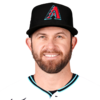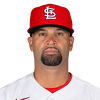For the first time in 14 years, the average MLB player's salary fell from one year to the next. That's a curious outcome, given that league-wide revenue continues to explode, year after year. A year ago, ESPN bought BAMtech, the tech and streaming powerhouse spawned by MLB Advanced Media; that deal gave each Major League Baseball team a payout of $50 million, before a single game ticket, foam finger, or dollar of TV revenue was earned.
This was merely the most obvious marker of a trend that dates back a while now. In 2002, players earned about 58 percent of the sport's total revenue, compared to just 42 percent a decade later. While finding exact figures isn't easy up to the moment, teams banking record amounts of cash and getting huge payouts from streaming deals while the rank-and-file player actually makes less money hints at the gap only widening.
A big part of the problem is the system that the players' union head man Marvin Miller worked so hard to create decades ago. A system that granted free agency to players after six years of major league service time with arbitration awards for players before that marked a gigantic improvement over baseball's status quo, when the reserve clause ruled and teams controlled every aspect of players' employment.
What was once a revolutionary system swinging more power to players now looks like a trap. Front offices are run by the shrewdest, most risk-averse group of operators the game has ever seen. They know that baseball players today tend to peak around their mid-20s. They also know that players typically don't bank the six years of service time they need to hit free agency until their late 20s or early 30s, with subsequent rounds of free agency occurring years and years past players' typical peak age.
So first-time free agents who aren't either true superstars or uncommonly young like Bryce Harper or Manny Machado are getting squeezed. Meanwhile, capable veterans in their 30s are having to settle for bottom of the barrel deals, millions (or even tens of millions) less than they would have pulled down a generation earlier.
All of this is why, three years before the current MLB collective bargaining agreement is due to expire, there are already rumblings of a potential labor stoppage. If that were to happen, it would be the first of its kind since the owners tried to foist a salary cap on players rather than sharing revenue between themselves in 1994.
The players would be justified to strike too. Given the demographics of the current game and the way front offices are run today, simply letting contracts play out according to the status quo might only deepen the divide between owners' share of revenue, and the money taken in by players. Negotiating for a system in which players get a guaranteed share of the sport's revenue would be both the wise and fair thing to do. Taking a hard-line stance if owners balk at such a proposal could be the painful, but warranted thing to do.
This brings us to a column that I used to call "Baseball's Worst Contracts," but will no longer. Looking at every deal through the prism of saving billionaire owners a few million dollars stops making sense when players aren't getting their fair share. So rather than call the 15 most player-friendly deals in the sport the worst, we'll just call them the get-paid contracts. Sure, Player X might be hitting a buck-ninety and sitting on your favorite team's disabled team half the year. But you know what? He got paid, and somebody should.
Here then are the 15 players who've done the best job of getting paid, with contracts that far outstrip what they've done -- and are likely to do going forward -- on the field.
Honorable Mention
Honorable Mention: Prince Fielder, David Wright, Bobby Bonilla, and other retired players still earning big bucks.
It's one thing for a player to make big money while struggling to hit his weight or putting up ERAs that resemble airplane models. It's another to make well into eight figures per season years after injuries have forced you into retirement, the way they did for Fielder (whose nine-year, $214 million deal doesn't expire until the end of the 2020 season) and Wright (two more years left at $27 million), with insurance covering the bulk of both players' final two years under contract. And it's still another thing to get paid $1.19 million every July 1 through 2035, the way Bobby Bonilla (retired in 2001) does.
Tip of the cap to all the players who got their big payday before their powers left them, or got on that sweet, sweet deferred payments train, becoming a delightful meme for the rest of time.
Honorable Mention, Part 2: Troy Tulowitzki, Pablo Sandoval, etc.
These players signed enormous deals, then fell off the face of the Earth due to injuries, ineffectiveness, or both. They're now either playing elsewhere or seeking employment elsewhere for league-minimum salaries, with the original teams that doled out all that cash now left holding the bag. The dead money bag.
Honorable Mention, Part 3: Patrick Corbin
The statistical indicators -- third-highest strikeout rate and second-best swing-and-miss rate in the National League -- point to Corbin's 2018 breakout being legitimate, with the lefty's slider being one of the most devastating pitches in all of baseball. Still, look at the history of big-money, long-term contracts for pitchers, think about the huge percentage of them that failed, then ask yourself if a pitcher who turns 30 in July, with one Tommy John surgery already on his ledger and only one truly elite season on his resume, will be the guy to do it. So get paid, sir! And let your employers gripe over your windfall in 2022 and beyond.
The Get-Paid All-Stars
Darvish was the pitching star of the 2017 class, the big arm to replace Jake Arrieta and fortify the Cubs rotation well into next decade. The move didn't come without trepidation in Wrigleyville, though. Here's what team president Theo Epstein had to say about the six-year, $126 million deal bestowed on Darvish.
"You don't want to make a living or habit out of trying to solve your problems with high-price pitching free agents because over the long run there's so much risk involved that you really can hamstring your organization. But we have a lot of players who have reasonable salaries who contribute an awful lot who might put us in a position to consider it going forward and in the future… It's not our preferred method. We would prefer to make a small deal and find another Jake Arrieta, but you can't do that every year, either."
Epstein's right -- making huge bets on pitchers is indeed about the biggest risk you can take in baseball. Darvish started his Cubs career by flashing an ugly 4.95 ERA through his first eight starts, never making it past six innings, and failing to make it out of the fifth five times. Then, the injury bug struck, whacking him with shoulder, elbow, and triceps injuries. After failing to make it through rehab, Darvish finally succumbed to season-ending surgery in September.
There are probably some in the industry who still view Darvish as a big-upside arm, someone who could anchor the Cubs staff and make good on that contract. That's the hopeful view. The reality is that Darvish has now missed half a season with neck and shoulder injuries (2016), all but eight starts due to multiple arm injuries (2018), plus all of 2015 following Tommy John surgery. He's also 32 years old, with the workload concerns that come with being a superstar in the ride-your-ace-'til-he-drops culture of high-school baseball in Japan.
For a team that purports to be risk-averse, it's a bit jarring to have not one but two potentially giant albatrosses on the roster. (More on the second one later.)
In 2015, the Kansas City Royals won the World Series. They did so in large part thanks to a loaded and wildly talented bullpen. Their starting pitchers, on the other hand, were pretty lousy, finishing 20th in park-adjusted ERA and 21st in park-adjusted fielding-independent pitching. The league took notice, with teams investing more heavily in relief pitching, managers pulling out quicker hooks for their starters, and the old way of handling a staff slowly evaporating -- culminating in the Rays pushing starting pitchers out of existence on many nights.
As the rest of the league zigged, the Giants zagged. Just a few weeks after the Royals hoisted the trophy, the Giants shelled out $220 million for a pair of starters who'd both be over 30 when they threw their first pitch in black and orange. Year one of the experiment worked brilliantly, as both Samardzija and fellow free-agent-turned-Giant Johnny Cueto fired 200-plus innings, with quality results. By year three, the wheels had come flying off. Samardzija lasted just 10 starts last season, imploding with a 6.25 ERA.
You could argue that Samardzija's a prime bounceback candidate, given that the shoulder injury that knocked him out for most of the season also chopped two miles per hour off his fastball and wrecked his numbers. Or you could ask how much a pitcher about to turn 34 coming off a serious injury with horrific numbers might make on the open market. Because the answer would be a helluva lot less than $20 million a year.
When trying to beat an arch rival, teams typically go the conventional route, assembling as much top-tier talent as possible. Coaxing a player to a career year, having that player's career year culminate in a home run to lead off Game 7 of the World Series that would break a 108-year curse (thereby convincing your arch rival to sign said player to a huge five-year deal), only to have that player start a precipitous decline that culminates in the worst season by any player in the entire National League is some next-level strategery.
Fowler's brutal .180/.278/.298 effort at the plate came with a three-mph drop in exit velocity, a defensive falloff that made him one of the worst outfielders in the league, and a season-ending broken left foot for bad measure. The Cardinals are saying that Fowler is their starting right fielder heading into next season. This is a truly terrible idea.
Forget risk profiles or health concerns. Sometimes a team throws a big contract at a player and you know it's going to fail, because he's simply not very good.
So it was with Desmond. The Rockies did correctly recognize that their offense was a source of concern that could get even worse if not addressed. Lighting $70 million on fire did nothing to change that. Not only was this an exorbitant amount of money to hand to a roughly league-average hitter, it was made even worse by the Rockies asking Desmond to play out of position at first base. But here's the real head scratcher: By signing Desmond, the Rockies were acquiring a hitter who perennially ranked among the league leaders in groundball percentage. If you wanted to take advantage of a ballpark that not only inflates home run totals but also lifts combined doubles and triples totals more than any other park (by far), why would you go after a player who constantly kills worms with his bat?
Desmond has only regressed further as a hitter since coming to Colorado, banging out groundballs more frequently than any other batter in baseball over the past two seasons. At a time when the Rockies are winning more and pitching better than at any other point in franchise history, the Desmond contract remains a puzzler to everyone on the planet except for the player, and his accountant.
Let's check off the good news first. Myers is a solid hitter, clocking park-adjusted numbers 15 percent, 14 percent, 7 percent, and 7 percent better than league average during his time as a Padre. He was a capable first baseman before the Padres gave Eric Hosmer enough money to buy 100 La Jollas (more on that later), then was a willing if only sometimes able participant in the team's great Wil Myers Rover Experiment. He's also still just 28 years old.
Now the bad news. Myers' strikeout-to-walk rate has grown worse in each of the past three seasons, with a poor .318 on-base percentage as the reward last season. The Padres officially have nowhere to put him, now that Hosmer's entrenched at first, 80,000 young players are vying for the team's three starting outfield spots, and Myers convinced management in just a few weeks that he's not the answer at third base. Moreover, the 157 and 155 games played totals in 2016 and 2017 that had some observers thinking Myers might've finally shaken his injury-prone label? The label returned, after maladies ranging from oblique and foot problems to getting hit in the face by a batting practice ball conspired to wipe out half his season.
The Padres own the best farm system in baseball, and their newfound willingness to spend money has them kicking the tires on some of the flashiest non-Harper-and-Machado free agents and trade candidates out there. But if they become the big surprise team of 2019 and beyond, it's tough to imagine Myers being at the center of that rebirth. Even if he's being paid as if that were in the cards.
Once a mainstay in the loaded Nationals rotation, Zimmermann co-authored one of the most electric moments in the franchise's 14-year history, firing a no-hitter on the final day of the 2014 season, with an unreal finish to boot:
Unfortunately for Tigers fans, past results don't always translate to future performance. One of several nine-figure contracts doled out by late Tigers owner Mike Ilitch in his scramble to win a ring, Zimmermann's five-year, $110 million deal ranks as one of the biggest busts in recent baseball history. The right-hander's strikeout rate plummeted immediately upon his arrival in Detroit, he's averaged just 136 innings per season as a Tiger, and he served up gopherballs more often than all but two pitchers last season. He's still owed at least 10 times what a pitcher of his recent pedigree might be expected to collect on the open market.
Brodie Van Wagenen is, if nothing else, loyal to the core. The newly hired Mets general manager used to represent Cano at CAA. The faith that Van Wagenen showed in his client five years ago apparently remains alive and well, because he recently engineered a blockbuster trade to acquire Cano's services for the second baseman's age-36, -37, -38, -39, and -40 seasons. Even with the Mariners paying one-sixth of Cano's remaining deal, and even with the Mets unloading the remainder of iffy contracts for veterans Jay Bruce and Anthony Swarzak, that's still a hell of a gamble for one of the league's oldest everyday players, one who's coming off an 80-game suspension for PED use no less.
Cano did hit .303 with a .374 on-base percentage when he wasn't suspended and continued to capably field his position, but he also hit for less power than we've seen in three years. It's telling that other Mets GM candidates (like former Red Sox GM Ben Cherington) reportedly backed out of the hiring sweepstakes after ownership rejected plans for a rebuild. By throwing his lot behind an old and risky second baseman, Van Wagenen is trying to fight the youth and skill of the ascendant Braves and Phillies with heavy doses of hope and nostalgia. The Mets could still ride younger stars like Jacob deGrom, Noah Syndergaard, Brandon Nimmo, and Michael Conforto back into contention. Just don't bet on Cano playing a major role either way.
A decade ago, after considering his talent, age, and contract status, Evan Longoria ranked as the single-most valuable asset in all of baseball. Unfortunately, Father Time is undefeated, and the 33-year-old Longoria might not have much left in the tank.
Panned at the time for making the move, the Rays sending Longoria to the Giants after the 2017 season proved prescient, as the erstwhile elite slugger and Gold Glove defender hit just .244 with a .281 on-base percentage last season. By advanced metrics, that made Longoria roughly a replacement-level player, the kind of readily available pickup teams make for pennies on the dollar every winter. Longoria's still one of the best fielders in the league, but he needs to dramatically improve a faulty batting eye that's tanked over the past seven years if he has any hope of making San Francisco's gamble pay off even a little.
Imagine making your children, your children's children, your children's children's children, your children's children's children's children, and maybe four or five or more generations set for life, all because you had a stellar six months at the office. That's what Ellsbury did in 2011, when he hit .321/.376/.552, cranked 32 home runs, led the league in total bases, made the All-Star team, won a Gold Glove and Silver Slugger, and finished second only to Justin Verlander's season-long beatdown of American League hitters for league MVP honors.
At no other point in Ellsbury's Red Sox career did he even crack double digits in home runs. What he did do was demonstrate a propensity for long disabled-list stints, sandwiching that all-world 2011 campaign with a pair of washout seasons that saw him play in just 92 combined games. Call it a byproduct of being the Evil Empire, or a concerted effort to poach a player from their arch rival, or just plain irrational exuberance. Either way, the Yankees somehow decided to pay an injury-prone version of Lorenzo Cain nearly double what the actual, healthy version of Lorenzo Cain would rake in four years later.
Ellsbury didn't play a single game for the Yankees last season, and the Yankees still have to pay him J.D. Martinez money for the next two seasons. Jacoby Jr. Jr. Jr. Jr. Jr. Jr. Jr. Jr. Jr. will be thanking Brian Cashman when he's finishing up his senior year of college on Mars some time in the 24th century.
Blame it on cheap ownership groups, one of the smallest markets in baseball, or simply lacking the supporting casts to justify a big splash. For these and other reasons, the Padres have spent the better part of the past half-century developing a reputation for being one of the thriftiest franchises in baseball.
Maybe they should have kept it that way. The only two players on the Padres roster signed for more than two years are Wil Myers, and Hosmer. We already covered Myers' trials and tribulations, and, one year into the Hosmer deal, that one looks even worse. Here were just a few reasons why most of the baseball world was stupefied by the eight-year, $144 million contract San Diego threw at Hosmer a year ago:
- At a position where you usually need to hit for a ton of power to make up for a lack of defensive impact, Hosmer had never slugged .500 in a season, nor ever hit more than 25 home runs.
- You never want to bid on a player to match (or beat) the best outcome of his career (see also Jacoby Ellsbury). Hosmer posted the best offensive numbers of his career right before he hit free agency. He did so in part thanks to a career-high (and likely flukish) .351 batting average on balls in play. Even the biggest Hosmer fan had to bake some regression into his future projections.
- Not since Derek Jeter (and maybe former teammate Salvador Perez) has a player seen a bigger gap between a sky-high defensive reputation and a big thumbs-up from advanced stats. Hosmer won his fourth Gold Glove right before he signed with the Padres. Yet according to Baseball Info Solutions' Defensive Runs Saved, Hosmer was one of the worst defensive first baseman in the majors in 2016 and 2017, and never cracked the top 10 in that metric in his entire career.
- Overpaying for intangibles, or postseason heroics, is always asking for trouble. There's no way in hell Hosmer gets that kind of payday if he didn't happen to play with a bunch of other really good players who collectively pulled off one of the greatest storybook seasons in baseball history by winning the 2015 World Series after nearly three decades of playoff-less misery. Hosmer enjoyed a few flashpoint moments during that magical run, and won an ex post facto reputation as one of the fiery leaders of that plucky Royals team.
- The Padres lost 91 games in 2017, making it likely that Hosmer would be into his 30s the next time San Diego vied for a playoff spot. Unfortunately, baseball players tend to decline in their 30s.
Hosmer hit .253/.322/.398 in year one as a Padre, numbers that put him in line with luminaries like Jeimer Candelario and Jonathan Villar. Oy.
He'll likely miss all of 2019 after undergoing Tommy John surgery in August. Winning the bidding for a big-money free-agent starting pitcher is a textbook case of The Winner's Curse.
The advent of advanced defensive metrics and catch-all measures of value enabled teams to quantify players' contributions with their gloves as well as their bats.
That greater awareness of defensive value has also changed the way teams do business, with price tags for power hitters declining sharply in recent years, as the focus shifts toward more well-rounded talent. The eight-year, $184 million contract the Cubs handed to Jason Heyward three years ago is the most extreme example of the tide shifting too far in the other direction.
Granted, Heyward's skills weren't all defense-based when the Cubs signed him to the biggest contract in franchise history. Heyward was a good hitter, with four seasons of offense 20 percent or more above league average, on a park-adjusted basis. He was an elite baserunner, with three seasons of 20 or more steals and dozens of daring dashes for an extra base. And he was uncommonly young for a free agent, hitting the open market at age 26.
It hasn't worked out, to say the least. In retrospect we can see a bit of an Ellsbury problem here, with Heyward only once eclipsing 20 home runs, with too many groundballs and infield popups on his resume, and not enough line drives and flyballs. This was a bet on Heyward's glove remaining elite, and on his bat blossoming over time. Instead, the Cubs ended up with a platoon outfielder who's a below-average hitter, bringing with him the slow but steady defensive decline that typically starts to bog players down as they approach their 30s. Heyward's not a bad guy to have on your team by any stretch. You'd just never look at him today and invest five years at $21 million per, or even half that.
What are the odds the Angels would have brought Pujols back for 2018, given that he was the worst full-time position player in the majors the year before, and also the author of one of the worst seasons of 20-plus homers and 100-plus RBI in MLB history? That's doubly true when you see sluggers in their 20s putting up significantly better numbers and getting thrown overboard (including one of Pujols' former teammates).
This looked like a massive overpay by an overzealous owner from the moment it happened, and Pujols isn't likely to suddenly start turning things around as he nears his 40th birthday. It's sad to think that Pujols today looks more like an avatar for Mike Trout's wasted career in Anaheim and less like the player who posted one of the best 11-year starts to a career of all time, and looked to get his own statue in St. Louis. Of course getting paid all that money long past the point at which he should have isn't Pujols' fault at all. Hell, he can take a quarter-billion of Arte Moreno's money and build elaborate statues of himself all across the country, if the mood ever strikes.
There aren't many enduring roster-building lessons to be gleaned from the Tigers of recent vintage. Mike Ilitch desperately wanted to bring a World Series to Detroit, so he damned the torpedoes and made players like Prince Fielder, Victor Martinez, Jordan Zimmermann, and others far richer than he needed to.
Cabrera's a different breed, though. An owner less hungry for a championship could have reasonably broken the bank to retain a franchise player who was either the best or second-best hitter on the planet. What most (all?) other owners wouldn't have done, though, is fire a quarter-billion contract extension at said franchise player when he still had two full years remaining on his existing deal. This is what I wrote the day Cabrera's payday of a lifetime came to fruition:
Detroit would have been fully justified in signing its franchise player to a lucrative extension once his current deal had concluded.
But that time hadn't arrived. Not even close. In handing Cabrera this extension now, the Tigers are channeling the Phillies circa April 2010. Back then, Philly gave Ryan Howard a five-year, $125 million extension. Like Cabrera, Howard didn't offer much in the way of defensive or baserunning contributions, but he was an elite hitter and a durable player, and that's what the Phillies wanted to lock up. The problem is, they did so nearly two years before Howard would've become a free agent, committing to a player through the meat of his 30s much earlier than they needed to. The results have been disastrous. Howard's injuries started piling up, and his numbers started going down. Now, instead of each spring in Philadelphia bringing new hope, it brings another excuse to check the Howard contract countdown, which still has three years and $85 million remaining before the team will be free of the financial prison in which it foolishly placed itself.
The Tigers are probably in store for a similar fate. It may seem like a reach now, given his consistent excellence and generally consistent health (he did battle a groin injury during the 2013 playoffs that ultimately required surgery), but something will happen to Cabrera, just like something happened to Howard, because they're both human beings in addition to baseball players, and this is the kind of stuff that happens as people age.
Cabrera just followed the worst season of his career with the most-injured season of his career, managing just 38 games played in year five of this 10-year indulgence that is his contract. There's a good reason Scott Boras barely bothers approaching GMs anymore when it comes to shopping his top clients. He knows that in today's game, when nearly every GM is a tight-fisted Ivy League grad with reams of stat sheets and projection models who treats risk like the plague, only owners still have the potential to make a decision that comes far more from the heart than from the mind. Considering the near-infinite riches that keep landing in owners' pockets, with players sharing less and less of the wealth every year, count me as someone who wishes Mr. Boras all the luck in the world.
Davis just set a new MLB record for the lowest batting average in a season. Though he didn't quite set a new mark for worst season ever recorded by a full-time position player, he came awfully close, finishing with the fourth-worst season since 1900 by Wins Above (or in this case, way, way below) Replacement. So how is he still owed $110 million?!
Call it the perfect storm of bad process and bad timing. Davis was a 53-homer terror in 2013, and smashed 47 more long balls two years later. But Davis' bat went cold at the exact same time that the industry turned its back on paying power hitters, and right after he got his payday for the ages. Or put another way ...
... If your bosses were desperate to keep defying the odds and cracking the playoffs in the rough-and-tumble AL East, and your team was historically bad at both mining the international market and developing starting pitching, and your owner refused to spend big bucks on marquee free agents, and you were one of the few premium talents on the big league roster, and those in charge were so determined to elicit Bobby Bonilla jokes that they deferred a total of $42 million in payments, the last of which would hit your Swiss bank account in 2037, that's how you become the get-paid king of baseball.














































